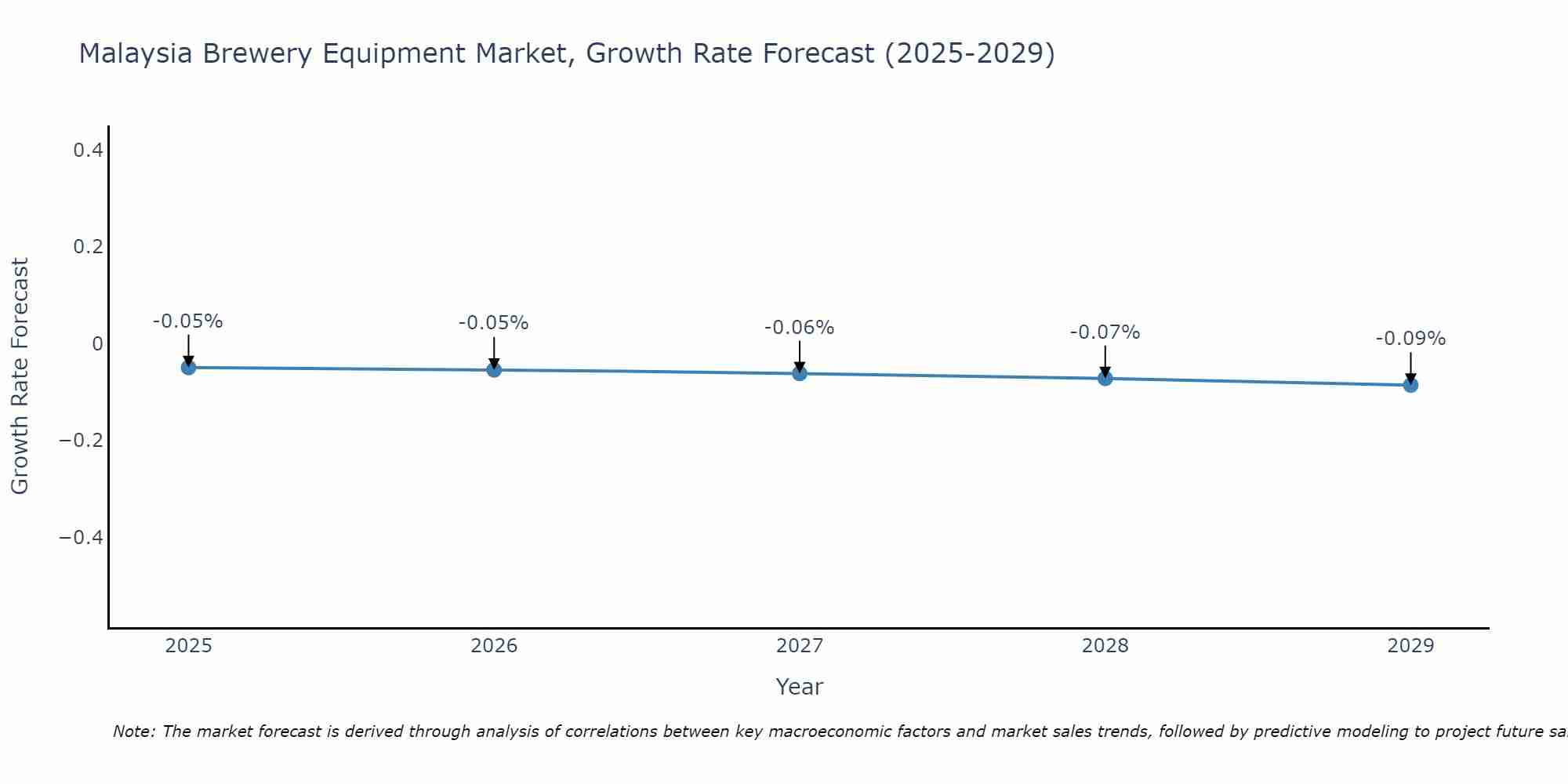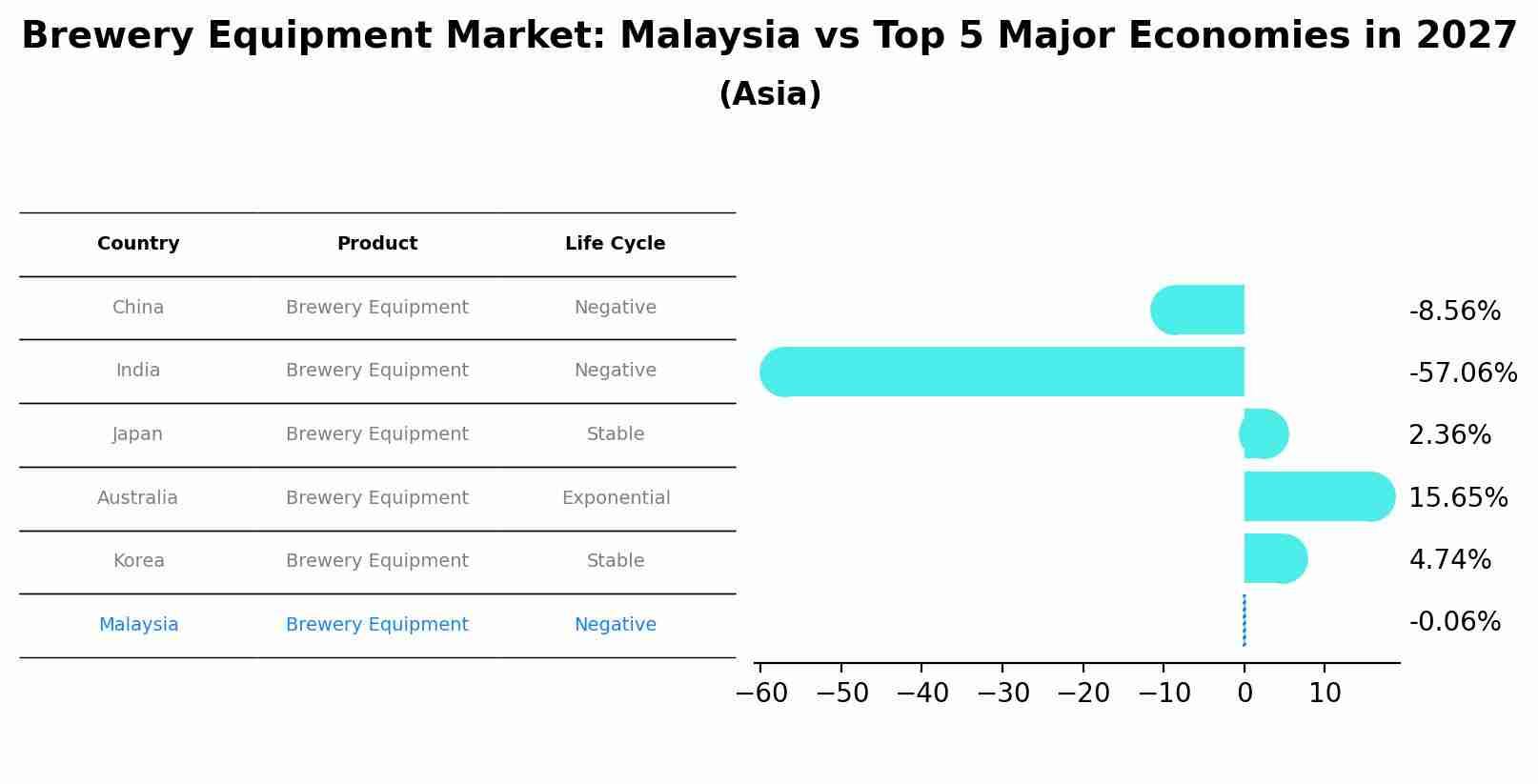Malaysia Brewery Equipment Market (2025-2031) Outlook | Revenue, Growth, Companies, Industry, Analysis, Share, Forecast, Value, Trends & Size
| Product Code: ETC285086 | Publication Date: Aug 2022 | Updated Date: Apr 2025 | Product Type: Market Research Report | |
| Publisher: 6Wresearch | No. of Pages: 75 | No. of Figures: 35 | No. of Tables: 20 | |
Malaysia Brewery Equipment Market Size Growth Rate
The Malaysia Brewery Equipment Market may undergo a gradual slowdown in growth rates between 2025 and 2029. Although the growth rate starts strong at -0.05% in 2025, it steadily loses momentum, ending at -0.09% by 2029.

Brewery Equipment Market: Malaysia vs Top 5 Major Economies in 2027 (Asia)
Malaysia's Brewery Equipment market is anticipated to experience a negative growth rate of -0.06% by 2027, reflecting trends observed in the largest economy China, followed by India, Japan, Australia and South Korea.

Malaysia Brewery Equipment Market Synopsis
The Malaysia brewery equipment market has witnessed notable growth in recent years, primarily due to the increasing popularity of craft beer and the expansion of microbreweries across the country. Craft beer has gained a dedicated following among consumers looking for unique and high-quality brews. This trend has prompted a surge in the establishment of small-scale breweries, which, in turn, has boosted the demand for brewery equipment such as fermentation tanks, kegs, bottling machines, and quality control instruments. Additionally, the rising middle-class population and changing consumer preferences have driven the consumption of premium and specialty beers. As a result, the Malaysia brewery equipment market is poised for continued expansion, with craft beer culture and innovation driving growth in the brewing industry.
Drivers of the Market
The Malaysia brewery equipment market is experiencing growth due to the rising popularity of craft breweries and the increasing consumption of alcoholic beverages. Craft breweries are expanding their operations, driving the demand for brewing equipment such as fermenters, kettles, and bottling lines. The trend toward locally brewed and unique beer flavors is further propelling the market.
Challenges of the Market
The brewery equipment market in Malaysia encounters challenges associated with regulatory compliance and market maturity. Adhering to strict regulations and quality standards in the brewing industry is essential but can be a complex process. Manufacturers need to ensure that their equipment meets all relevant requirements. Furthermore, the market`s maturity may lead to increased competition, requiring manufacturers to differentiate themselves through innovation, quality, and customer support.
COVID 19 Impact on the Market
The Malaysia brewery equipment market faced a series of challenges due to COVID-19 restrictions. The closure of bars, pubs, and restaurants, as well as restrictions on social gatherings, significantly impacted the hospitality and brewing industry. Many breweries had to reduce or suspend their operations temporarily. However, with the gradual reopening of the economy and the resilience of craft breweries, the market is expected to recover. As consumers return to their favorite establishments, breweries may consider investing in modern equipment to enhance efficiency, quality, and production capacity.
Key Players in the Market
The Malaysia brewery equipment market boasts key players like Krones AG, GEA Group, and Alfa Laval AB. These companies provide a comprehensive range of brewery equipment and solutions to meet the demands of the thriving craft beer industry in Malaysia. They focus on enhancing brewing processes and sustainability.
Key Highlights of the Report:
- Malaysia Brewery Equipment Market Outlook
- Market Size of Malaysia Brewery Equipment Market, 2024
- Forecast of Malaysia Brewery Equipment Market, 2031
- Historical Data and Forecast of Malaysia Brewery Equipment Revenues & Volume for the Period 2021-2031
- Malaysia Brewery Equipment Market Trend Evolution
- Malaysia Brewery Equipment Market Drivers and Challenges
- Malaysia Brewery Equipment Price Trends
- Malaysia Brewery Equipment Porter's Five Forces
- Malaysia Brewery Equipment Industry Life Cycle
- Historical Data and Forecast of Malaysia Brewery Equipment Market Revenues & Volume By Type for the Period 2021-2031
- Historical Data and Forecast of Malaysia Brewery Equipment Market Revenues & Volume By Macrobrewery Equipment for the Period 2021-2031
- Historical Data and Forecast of Malaysia Brewery Equipment Market Revenues & Volume By Craft Brewery Equipment for the Period 2021-2031
- Historical Data and Forecast of Malaysia Brewery Equipment Market Revenues & Volume By Mode of Operation for the Period 2021-2031
- Historical Data and Forecast of Malaysia Brewery Equipment Market Revenues & Volume By Automatic for the Period 2021-2031
- Historical Data and Forecast of Malaysia Brewery Equipment Market Revenues & Volume By Semi-automatic for the Period 2021-2031
- Historical Data and Forecast of Malaysia Brewery Equipment Market Revenues & Volume By Manual for the Period 2021-2031
- Historical Data and Forecast of Malaysia Brewery Equipment Market Revenues & Volume By End-use for the Period 2021-2031
- Historical Data and Forecast of Malaysia Brewery Equipment Market Revenues & Volume By Macro Brewery for the Period 2021-2031
- Historical Data and Forecast of Malaysia Brewery Equipment Market Revenues & Volume By Craft Brewery for the Period 2021-2031
- Malaysia Brewery Equipment Import Export Trade Statistics
- Market Opportunity Assessment By Type
- Market Opportunity Assessment By Mode of Operation
- Market Opportunity Assessment By End-use
- Malaysia Brewery Equipment Top Companies Market Share
- Malaysia Brewery Equipment Competitive Benchmarking By Technical and Operational Parameters
- Malaysia Brewery Equipment Company Profiles
- Malaysia Brewery Equipment Key Strategic Recommendations
Frequently Asked Questions About the Market Study (FAQs):
1 Executive Summary |
2 Introduction |
2.1 Key Highlights of the Report |
2.2 Report Description |
2.3 Market Scope & Segmentation |
2.4 Research Methodology |
2.5 Assumptions |
3 Malaysia Brewery Equipment Market Overview |
3.1 Malaysia Country Macro Economic Indicators |
3.2 Malaysia Brewery Equipment Market Revenues & Volume, 2021 & 2031F |
3.3 Malaysia Brewery Equipment Market - Industry Life Cycle |
3.4 Malaysia Brewery Equipment Market - Porter's Five Forces |
3.5 Malaysia Brewery Equipment Market Revenues & Volume Share, By Type, 2021 & 2031F |
3.6 Malaysia Brewery Equipment Market Revenues & Volume Share, By Mode of Operation, 2021 & 2031F |
3.7 Malaysia Brewery Equipment Market Revenues & Volume Share, By End-use, 2021 & 2031F |
4 Malaysia Brewery Equipment Market Dynamics |
4.1 Impact Analysis |
4.2 Market Drivers |
4.3 Market Restraints |
5 Malaysia Brewery Equipment Market Trends |
6 Malaysia Brewery Equipment Market, By Types |
6.1 Malaysia Brewery Equipment Market, By Type |
6.1.1 Overview and Analysis |
6.1.2 Malaysia Brewery Equipment Market Revenues & Volume, By Type, 2021-2031F |
6.1.3 Malaysia Brewery Equipment Market Revenues & Volume, By Macrobrewery Equipment, 2021-2031F |
6.1.4 Malaysia Brewery Equipment Market Revenues & Volume, By Craft Brewery Equipment, 2021-2031F |
6.2 Malaysia Brewery Equipment Market, By Mode of Operation |
6.2.1 Overview and Analysis |
6.2.2 Malaysia Brewery Equipment Market Revenues & Volume, By Automatic, 2021-2031F |
6.2.3 Malaysia Brewery Equipment Market Revenues & Volume, By Semi-automatic, 2021-2031F |
6.2.4 Malaysia Brewery Equipment Market Revenues & Volume, By Manual, 2021-2031F |
6.3 Malaysia Brewery Equipment Market, By End-use |
6.3.1 Overview and Analysis |
6.3.2 Malaysia Brewery Equipment Market Revenues & Volume, By Macro Brewery, 2021-2031F |
6.3.3 Malaysia Brewery Equipment Market Revenues & Volume, By Craft Brewery, 2021-2031F |
7 Malaysia Brewery Equipment Market Import-Export Trade Statistics |
7.1 Malaysia Brewery Equipment Market Export to Major Countries |
7.2 Malaysia Brewery Equipment Market Imports from Major Countries |
8 Malaysia Brewery Equipment Market Key Performance Indicators |
9 Malaysia Brewery Equipment Market - Opportunity Assessment |
9.1 Malaysia Brewery Equipment Market Opportunity Assessment, By Type, 2021 & 2031F |
9.2 Malaysia Brewery Equipment Market Opportunity Assessment, By Mode of Operation, 2021 & 2031F |
9.3 Malaysia Brewery Equipment Market Opportunity Assessment, By End-use, 2021 & 2031F |
10 Malaysia Brewery Equipment Market - Competitive Landscape |
10.1 Malaysia Brewery Equipment Market Revenue Share, By Companies, 2024 |
10.2 Malaysia Brewery Equipment Market Competitive Benchmarking, By Operating and Technical Parameters |
11 Company Profiles |
12 Recommendations |
13 Disclaimer |
- Single User License$ 1,995
- Department License$ 2,400
- Site License$ 3,120
- Global License$ 3,795
Search
Related Reports
- Portugal Electronic Document Management Market (2025-2031) | Strategy, Consumer Insights, Analysis, Investment Trends, Opportunities, Growth, Size, Share, Industry, Revenue, Segments, Value, Segmentation, Supply, Forecast, Restraints, Outlook, Competition, Drivers, Trends, Demand, Pricing Analysis, Competitive, Strategic Insights, Companies, Challenges
- France Electronic Document Management Market (2025-2031) | Strategy, Consumer Insights, Analysis, Investment Trends, Opportunities, Growth, Size, Share, Industry, Revenue, Segments, Value, Segmentation, Supply, Forecast, Restraints, Outlook, Competition, Drivers, Trends, Demand, Pricing Analysis, Competitive, Strategic Insights, Companies, Challenges
- Portugal Occupational Health & Safety Services Market (2025-2031) | Strategy, Consumer Insights, Analysis, Investment Trends, Opportunities, Growth, Size, Share, Industry, Revenue, Segments, Value, Segmentation, Supply, Forecast, Restraints, Outlook, Competition, Drivers, Trends, Demand, Pricing Analysis, Competitive, Strategic Insights, Companies, Challenges
- Netherlands Occupational Health and Safety Services Market (2025-2031) | Strategy, Consumer Insights, Analysis, Investment Trends, Opportunities, Growth, Size, Share, Industry, Revenue, Segments, Value, Segmentation, Supply, Forecast, Restraints, Outlook, Competition, Drivers, Trends, Demand, Pricing Analysis, Competitive, Strategic Insights, Companies, Challenges
- Belgium and Luxembourg Facility Management Market (2025-2031) | Strategy, Consumer Insights, Analysis, Investment Trends, Opportunities, Growth, Size, Share, Industry, Revenue, Segments, Value, Segmentation, Supply, Forecast, Restraints, Outlook, Competition, Drivers, Trends, Demand, Pricing Analysis, Competitive, Strategic Insights, Companies, Challenges
- Russia Women Intimate Apparel Market (2025-2031) | Strategy, Consumer Insights, Analysis, Investment Trends, Opportunities, Growth, Size, Share, Industry, Revenue, Segments, Value, Segmentation, Supply, Forecast, Restraints, Outlook, Competition, Drivers, Trends, Demand, Pricing Analysis, Competitive, Strategic Insights, Companies, Challenges
- Africa Chocolate Market (2025-2031) | Size, Share, Trends, Growth, Revenue, Analysis, Forecast, industry & Outlook
- Global Hydroxychloroquine And Chloroquine Market (2025-2031) | Industry, Trends, Size, Outlook, Growth, Value, Companies, Revenue, Analysis, Share, Forecast
- Saudi Arabia Plant Maintenance Market (2025-2031) | Industry, Size, Growth, Revenue, Value, Companies, Forecast, Analysis, Share & Trends
- Taiwan Electric Truck Market (2025-2031) | Outlook, Industry, Revenue, Size, Forecast, Growth, Analysis, Share, Companies, Value & Trends
Industry Events and Analyst Meet
Our Clients
Whitepaper
- Middle East & Africa Commercial Security Market Click here to view more.
- Middle East & Africa Fire Safety Systems & Equipment Market Click here to view more.
- GCC Drone Market Click here to view more.
- Middle East Lighting Fixture Market Click here to view more.
- GCC Physical & Perimeter Security Market Click here to view more.
6WResearch In News
- Doha a strategic location for EV manufacturing hub: IPA Qatar
- Demand for luxury TVs surging in the GCC, says Samsung
- Empowering Growth: The Thriving Journey of Bangladesh’s Cable Industry
- Demand for luxury TVs surging in the GCC, says Samsung
- Video call with a traditional healer? Once unthinkable, it’s now common in South Africa
- Intelligent Buildings To Smooth GCC’s Path To Net Zero













